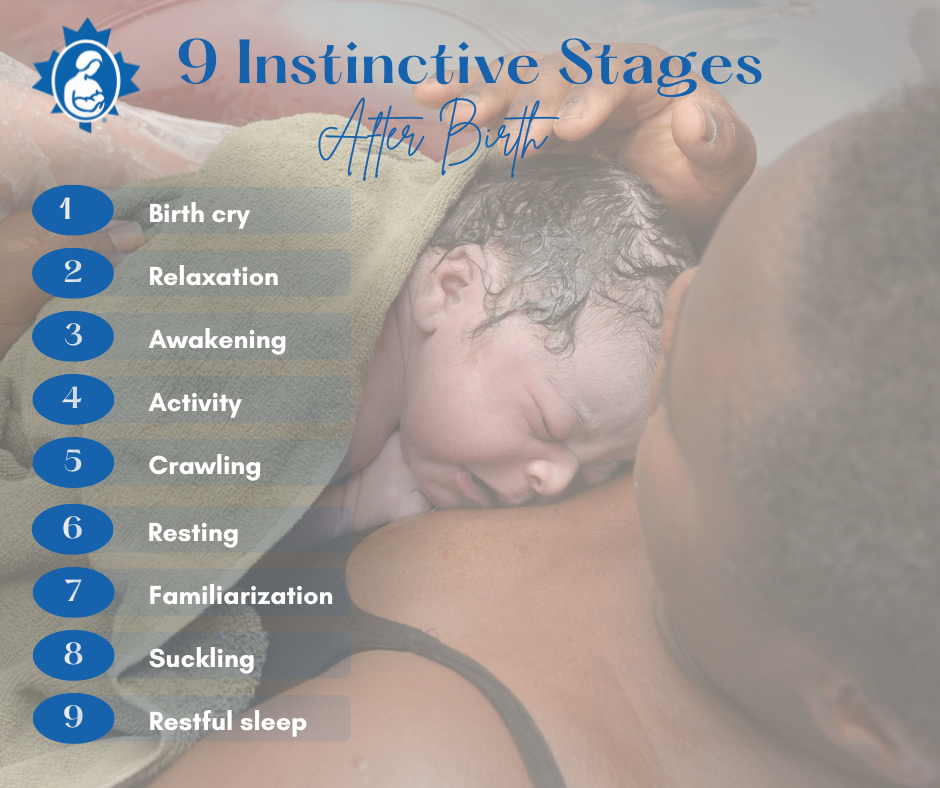
The experiences of the first hour after your baby arrives can have a major impact on breastfeeding. Knowing what is normal behaviour in this time period and how to create the space for your baby to move through these normal stages is as important as knowing the stages of labour.
Your baby will go through nine stages during the first couple of hours after birth. Skin-to-skin contact between you and your baby provides the natural location, and the cues, for your baby to move through these nine stages. If you are not able to hold your baby skin to skin during this time, then the baby’s father, your partner, another family member or support person can take on this role. If there are medical reasons why your baby can’t be held skin to skin with you right after birth, then start as soon as possible. Continued skin-to-skin contact with your baby has benefits for many weeks.
The nine stages happen in a specific order, and they will happen on their own without any help.
Stage 1: Birth cry. This happens immediately after birth as your baby’s lungs expand with the first breath. Every parent waits eagerly to hear that first cry.
Stage 2: Relaxation. Right after the first cry most babies will relax. This is when your baby can be placed skin to skin on your chest and covered with a blanket. Your baby’s head should not be covered. Your baby will be fully relaxed and won’t move.
Stage 3: Awakening. After a few minutes your baby will start to open his eyes and move his head and shoulders.
Stage 4: Activity. After about five minutes the movements will become stronger and your baby will make sucking and rooting motions.
Stage 5: Crawling: If your baby is resting on you, about 35 minutes after birth your baby will start to make crawling movements with her arms and legs and will approach the breast and nipple.
Stage 6: Resting. Your baby may have a few minutes of activity and then go back to a resting state several times over the first hour.
Stage 7: Familiarization. For the next half hour your baby will familiarize herself with the breast and nipple. Her hands may touch and massage your breast and your baby may mouth and lick at your nipple.
Stage 8: Suckling. Finally the baby will self-attach to the nipple. Once your baby is latched onto your breast, he will begin to suckle. This usually happens about an hour after birth. If you were given any medications during labour, they will have passed to your baby through the placenta. This may mean that it takes more time in skin-to-skin contact for your baby to move through the stages and be ready to suckle.
Stage 9: Restful sleep. The final stage, which usually happens about 90 minutes to 2 hours after birth, is when your baby falls into a restful sleep. You may be ready for a nap at that time too.
You do not have to remember the stages as long as you remember to create the space in which they can happen on their own. This means having your baby skin to skin on your chest, if possible, or on another family member, covered by a warm dry blanket. Don’t try to rush the steps, they will happen naturally. Pushing your baby to latch on before she is ready may prevent your baby from getting a good latch for that first feeding.
Please consider supporting LLLC.
References:
Widström, A.M., Brimdyr, K., Svensson, K., Cadwell, K., Nissen, E. (2020). A plausible pathway of imprinted behaviors: Skin-to-skin actions of the newborn immediately after birth follow the order of fetal development and intrauterine training of movements. Medical Hypotheses, Volume 134.
Updated August 2022
